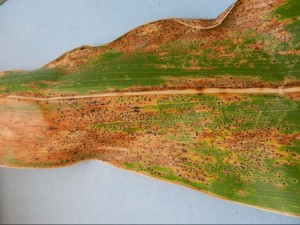WOOSTER, Ohio – A new corn disease has been spotted in fields near the Indiana-Ohio border that, while it isn’t a big threat for growers this year, could potentially cause some concern in impacted fields next year.
That is, if the fungus can survive the harsh Midwest winter.
So says Pierce Paul, a corn and small grain Extension specialist with the College of Food, Agricultural, and Environmental Sciences at The Ohio State University. Called tar spot, this corn disease is not only new to Indiana and Illinois, where it was first reported, its appearance is a first in the U.S., Paul said.
While the fungal disease is typically found in Mexico, South America and the Caribbean, tar spot is thought to have been transported to the Midwest earlier this season by Tropical Storm Bill, according to a report from Reuters news service.
The U.S. Department of Agriculture confirmed the disease was found in four Indiana and three Illinois locations, said Paul, who is also a plant pathologist with OSU Extension and the Ohio Agricultural Research and Development Center.
OSU Extension and OARDC are the outreach and research arms, respectively, of the college.
“We don’t want to cause a panic, but we do want to raise awareness of the issue and let growers know that this disease is out there,” he said.
Tar spot begins as oval to irregular bleached to brown lesions on leaves in which black spore-producing structures are formed. Affected areas of the leaf will have a rough or bumpy feel to the touch. Signs of tar spot can also appear on leaf sheaths and husks.
“Because tar spot is generally considered a tropical disease, it’s unlikely that the fungus will survive the harsh Midwest winter to become established here,” Paul said. “We’ll just have to wait and see and do more research on the disease in the Midwest.”
While most corn growers are either harvesting corn now or their crops are in the drying down stage, the disease is still detectable on dry, senescent leaves, he said. Growers who suspect they’ve found it in their fields can send samples to Paul at OARDC, 1680 Madison Ave., Wooster, Ohio, 44691, to have the samples lab tested to determine which fungus — Phyllachora maydis or Monographella maydis — may be present.
“At this point, only P. maydis-infected plants have been found,” he said. “Both fungi would have to be found before substantial yield loss occurs.
“Growers who find tar spot in their fields may want to take note of the hybrid they’ve used this year and avoid using that same hybrid next year just in case the fungus survives the winter.”
Pierce Paul
330-263-3842
paul.661@osu.edu

